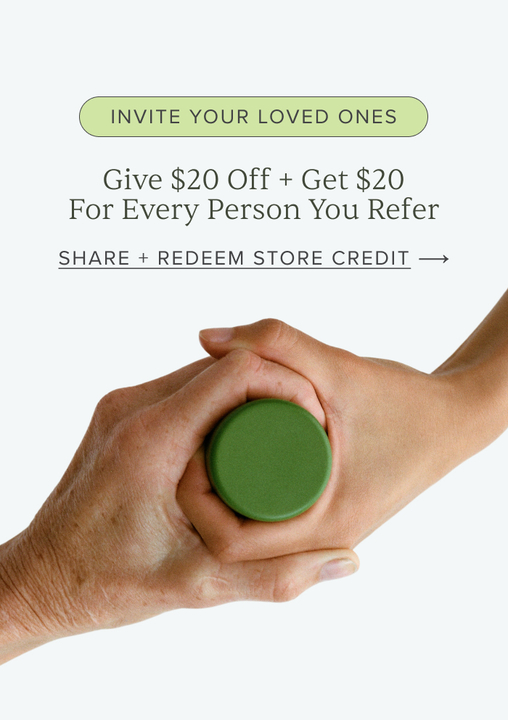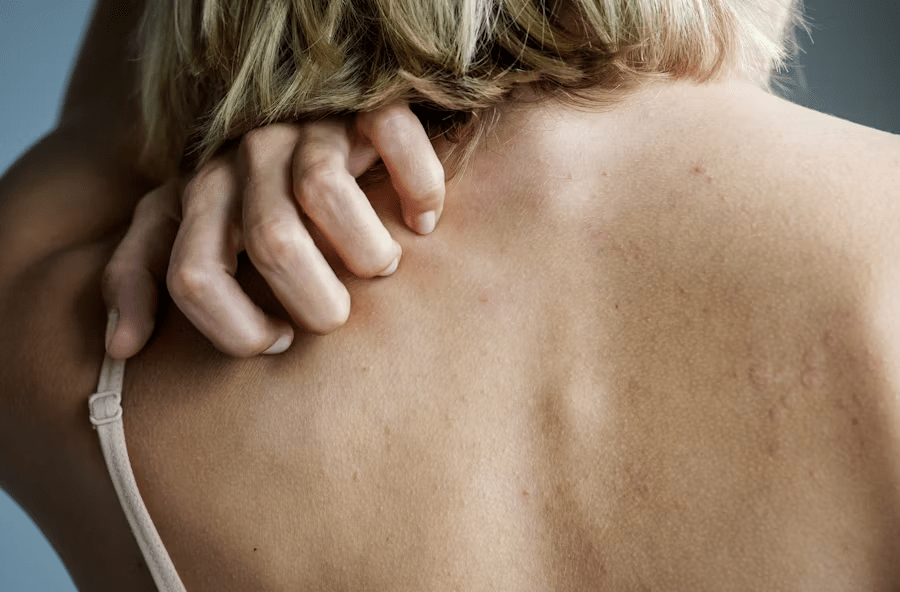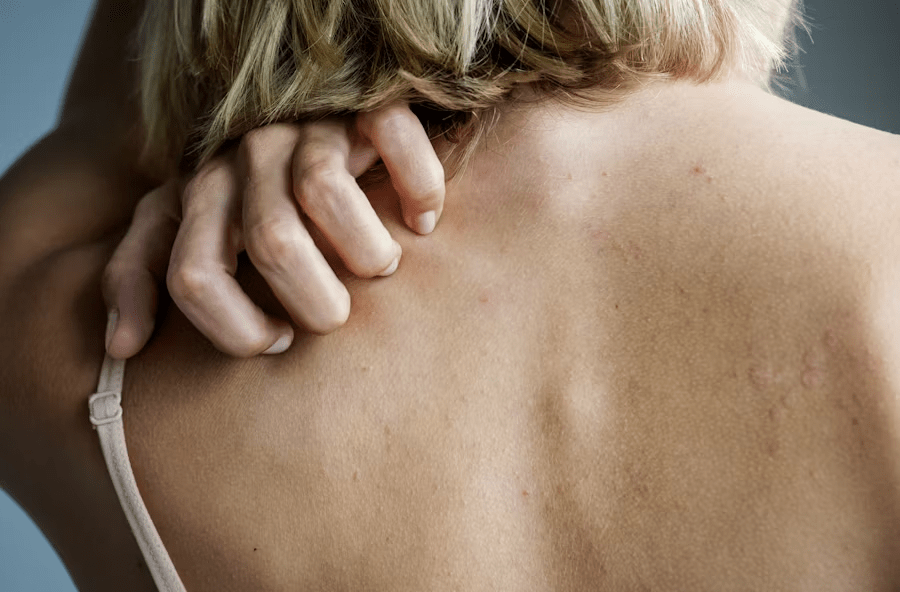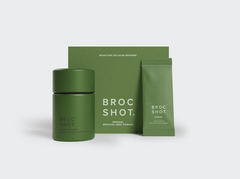Key Takeaways:
- Appearance + Feel: Eczema typically appears as patches that aren’t clearly defined and feel very itchy at first. Psoriasis, on the other hand, tends to form thicker, sharply outlined plaques with a silvery scale. These can also be itchy or even sore.
- Where It Shows Up: Eczema usually shows up in the skin folds, like the inner creases of the elbows and knees. Psoriasis, on the other hand, often affects the outer parts of the elbows and knees, as well as the scalp, nails, and lower back.
- Care Path: Both eczema and psoriasis can improve with daily skin care and avoiding triggers. A dermatologist can diagnose these conditions and create a treatment plan that fits your needs. Lifestyle choices also play a role—things like a balanced diet, stress management, and compounds such as Natural Sulforaphane, which supports the body’s antioxidant defenses and activates the NRF2 pathway, may help.
If you’ve noticed red, flaky, irritated skin, it can be hard to know which skin condition you’re dealing with. Eczema and psoriasis are skin conditions that overlap in how they look and feel, but they’re not the same. Understanding which one you have is the first step toward finding the right care with your dermatologist.
At Broc Shot, we’re built around the power of bioactive natural sulforaphane from whole broccoli seed powder. Our goal is simple: to support skin-smart habits that complement your treatment plan. We keep things straightforward, evidence-based, and supportive.
Quickly Compare: Eczema Vs. Psoriasis at a Glance
If you’re wondering what the difference is between eczema and psoriasis, start with the feel and borders. Eczema is itch-first with softer, less defined patches that favor skin folds (inner elbows, behind the knees). Psoriasis forms thicker, sharply edged plaques with silvery scales on the elbows, knees, scalp, and lower back; nails may also become pitted or lifted.
Eczema and psoriasis don’t always flare for the same reasons. Eczema often reacts to things like dry skin, heat, sweating, or everyday irritants. Psoriasis, on the other hand, can be triggered by infections, skin injuries, stress, or even certain medications. If your skin feels like a mix of both, a dermatologist can help sort it out with a clear diagnosis.
How It Feels, How It Looks, Where It Shows
Eczema usually starts with intense itching—often before you even see a rash. Scratching then brings the rash out. The skin feels very dry and sensitive, and during flares, it can ooze or form a crust. The patches don’t have sharp edges and can look red or pink on lighter skin, or dark, grayish, or violet-hued on darker skin. They’re often scaly, though not as thick as psoriasis. Eczema commonly shows up in skin folds like the insides of the elbows and knees, as well as on the neck, eyelids, and hands. It’s especially common in children, though it can appear at any age.
Psoriasis can itch too, but it often comes with other sensations—plaques that feel sore, tight, or even burning. The skin is thicker and covered with stacked, silvery-white scales. If a scale is removed, tiny pinpoint bleeding may appear, known as the Auspitz sign. Psoriasis can also affect the nails, leading to pitting or lifting, and in some cases involves the joints (psoriatic arthritis). It typically shows up on the outer surfaces of the elbows and knees, as well as the scalp, lower back, and nails.
Common Triggers of Eczema and Psoriasis
Eczema triggers often pile up. Dry air and hot showers strip the skin of moisture, leaving it more sensitive. Fragrances and harsh detergents can irritate an already fragile barrier, while sweat and common allergens like dust mites or pet dander add extra itch. Stress makes things worse, fueling the itch-scratch cycle that keeps flares going. Practical steps include taking shorter, lukewarm showers, choosing fragrance-free products, and moisturizing right after bathing.
Psoriasis has its own set of triggers. Infections—especially strep throat—are well-known culprits. Skin injuries such as cuts, scratches, tattoos, or even friction can spark new plaques in those exact spots, a reaction called the Koebner phenomenon. Stress can also feed flares, and certain medications may worsen symptoms. Practical moves include staying on top of infections with medical care, protecting skin from injury when possible, managing stress through techniques like mindfulness or gentle exercise, and reviewing medications with a healthcare provider if flares persist.
Diagnosis + Care
When you see a dermatologist, they’ll usually start by asking about your skin story: when the rash began, how it feels (does it itch, burn, or feel tight?), where it shows up, and what seems to make it better or worse. The spots themselves give clues too—whether the edges are fuzzy or sharply defined, and where they appear on your body.
If it’s still tricky to tell, a few simple tests can help:
- Patch testing: small stickers with common allergens are placed on your back to see if your skin reacts. This can help determine if an allergy is driving eczema.
- Dermoscopy: a special magnifying tool that lets the dermatologist see skin changes up close.
- Skin biopsy: taking a tiny sample of skin (about the size of a sesame seed) to look at under a microscope, which can confirm psoriasis.
- Nail and joint check: psoriasis can affect nails and, in some people, cause joint pain (psoriatic arthritis).
- KOH scraping: gently scraping the skin to check for fungus under the microscope, to rule out other causes.
What Is Eczema?
Eczema—or atopic dermatitis—is a long-term skin condition that tends to come and go. It’s marked by very itchy, dry, and sensitive skin. It often starts in childhood, but adults can develop it too. A hallmark of eczema is a compromised skin barrier, which lets irritants and allergens in more easily and allows water to escape, driving more itch and more scratching.
Common signs you’ll notice include:
- Itch first, then rash
- Ill-defined, dry, scaly patches (may ooze/crust)
- Shows up in body folds, neck, hands, eyelids
- Tends to wax and wane with triggers like dry air, hot showers, fragrances, and stress
What Is Psoriasis?
Psoriasis is a skin condition driven by the immune system, which makes skin cells grow too quickly. This leads to thick, well-defined patches (plaques) covered with those silvery-white scales. These spots can itch, feel sore, or even burn, and they often show up on the scalp, elbows, knees, and lower back. Psoriasis can also affect the nails as stated earlier, causing tiny dents (pitting), lifting from the nail bed, or thickening—changes that most people with psoriasis will notice at some point. In some cases, it also affects the joints, a condition called psoriatic arthritis.
Common signs you’ll notice include:
- Thicker, well-defined plaques with stacked scale
- May sting or feel tight; itch varies
- Nails can pit, crumble, or lift from the nail bed
- Often symmetric on the extensor surfaces, scalp, and back
Treatment of Eczema and Psoriasis
For eczema, care usually focuses on repairing the skin barrier with thick moisturizers, avoiding or controlling triggers, and using prescription creams or ointments (like steroid or non-steroidal options). More stubborn cases may benefit from light therapy or oral/ injectable medicines.
For psoriasis, treatment can include topical steroids, vitamin D–based creams, and keratolytics (to soften thick scale). Some people also do well with phototherapy or, in more severe cases, systemic or biologic medications prescribed by a specialist.
Everyday skin wins for both conditions include keeping showers short and lukewarm, choosing gentle fragrance-free products, moisturizing right after bathing, managing stress, and getting steady, good-quality sleep.
Nutrition can also play a supportive role. Some people add bioactive natural sulforaphane—a plant compound clinically studied for turning on NRF2, the body’s natural antioxidant defense switch. A high-quality, third-party tested version like Broc Shot, made from whole broccoli seed powder, can be taken daily with or without food. Used consistently alongside your dermatologist’s plan, it may help reduce inflammation, support gut health, and enhance detoxification as part of a simple routine. In fact, Broc Shot is the first supplement to be recognized by the National Psoriasis Foundation.
Daily Care That Supports Both Conditions
Your dermatologist-directed treatment is step one. The habits below can support skin relief and complement your care plan:
- Short, lukewarm showers; pat dry and moisturize within minutes.
- Choose fragrance-free, gentle cleansers and detergents.
- Hydrate skin daily, even when you’re not flaring.
- Manage stress and prioritize steady sleep.
- Consider nutrition patterns that emphasize whole foods, fiber, and balanced omega-3s (talk with your clinician if you’re on prescription therapies).
Both eczema and psoriasis share a common theme: oxidative stress and inflammation in the skin. Research shows that switching on the body’s NRF2 pathway can be a powerful way to protect skin and calm inflammation. One of the best-studied natural activators of this pathway is sulforaphane, a compound found in broccoli seeds.
Broc Shot’s approach uses bioactive natural sulforaphane from whole broccoli seed powder. It’s made to the highest-quality standards and third-party tested for purity and potency. You can take it daily, with or without food, as part of a simple routine. Consistent use supports your body’s detox processes, helps reduce inflammation, and promotes gut balance—all of which play a role in healthier skin.
If you’re building a supportive stack for resilience and skin health, explore our best supplements for skin collection to pair with your dermatologist’s plan. You’ll also find our sulforaphane supplement, a bioactive option centered on natural sulforaphane, plus other supplements for psoriasis to round out a simple, daily routine. Broc Shot can help enhance detoxification, minimize inflammation, and support gut restoration when used consistently alongside a supportive lifestyle.
Where Natural Sulforaphane Can Fit For You
We don’t frame supplements as cures. Instead, we see them as tools to support the body’s own pathways—always alongside the plan you and your practitioner decide on.
Natural sulforaphane, derived from broccoli seeds, has been clinically studied for its skin-relevant antioxidant and anti-inflammatory effects through the NRF2 pathway. Early human studies, along with preclinical research, suggest it may help with psoriatic-type inflammation and oxidative stress. Sulforaphane has been shown to influence certain immune cells (T-cells) and improve psoriasis-like skin changes in experimental models.
Your prevention plan also becomes stronger when you pair it with smart habits—steady sleep, stress management, nutritious food, sun protection, and daily sulforaphane. Taken consistently, it supports detoxification, helps calm inflammation, and promotes gut balance as part of a holistic approach to skin health.
Curious how sulforaphane impacts your skin? Explore sulforaphane benefits for skin for a deeper look.
Final Thoughts
Eczema and psoriasis can look alike on the surface, but there are important differences if you take a deeper look. Clues like how itchy the skin feels, how thick or well-defined the plaques are, where they show up, and whether the nails are involved all help tell them apart. For a diagnosis and to get a plan tailored to your skin and your lifestyle, see your dermatologist.
Keep your daily care simple. Rely on high-quality, third-party tested basics, and consider adding bioactive plant support like natural sulforaphane from Broc Shot, powered by whole broccoli seed powder. When taken regularly, it can support detoxification, help calm inflammation, promote gut balance, and round out your core routine.
Read Also:
- Nutrient-Rich Foods That May Boost Immunity While Undergoing Chemotherapy
- Sulforaphane Benefits for Skin: Natural Support for Radiance And Repair
- How Compounds in Broccoli Sprouts May Support Cancer Defense
Frequently Asked Questions About the Difference Between Eczema and Psoriasis
How can I quickly tell the difference between eczema and psoriasis at home?
Start by noticing how it feels and looks. Eczema usually itches intensely and appears as patches with softer, less-defined edges. Psoriasis, in contrast, forms thicker plaques with sharp borders and a silvery scale. Location gives more clues—eczema often settles in skin folds (like the inside of elbows and knees), while psoriasis tends to appear on outer elbows, knees, and the scalp. When it’s unclear, the best step is to see a dermatologist for a diagnosis.
Can children get psoriasis, or is it usually eczema?
Eczema is especially common in children, but psoriasis can show up in kids too. Because the two can look similar, doctors sometimes use the term “psoriasiform dermatitis” during the evaluation. A dermatologist can sort out the difference with an exam and, if needed, simple tests.
What's the difference between psoriasis and eczema on the scalp?
Both eczema and psoriasis can affect the scalp. With eczema, the scalp usually feels very itchy and has more widespread flaking, similar to dandruff. Psoriasis, on the other hand, tends to form thicker, well-defined plaques that can even extend beyond the hairline. If you also notice nail pitting or plaques on the elbows and knees, that suggests psoriasis.
Do nails help show the difference between eczema and psoriasis?
Nail changes can be an important clue. In psoriasis, nails may develop tiny dents (pitting), lift from the nail bed (onycholysis), or become thickened. These changes are uncommon in eczema. If you notice your nails changing, mention it to your dermatologist—it can help point toward the right diagnosis.
Are moisturizers enough, or do I need prescriptions?
Daily moisturizers and gentle cleansers are foundational for both conditions. Many people also need prescription topicals, light therapy, or systemic medications, depending on severity. A dermatologist will tailor the plan to your skin and triggers.
Can stress really flare both eczema and psoriasis?
Stress doesn’t cause either condition by itself, but it can worsen inflammation and barrier function, feeding flares. Pair medical care with realistic stress tools—sleep structure, movement, and simple breathing work—to help calm the cycle.
Is diet relevant when sorting out the difference between eczema and psoriasis?
Diet isn’t a replacement for medical care, but healthy eating can support your skin. The right patterns may help lower overall inflammation and strengthen the skin barrier. If you think certain foods may trigger your eczema, talk with your clinician about testing or tracking to see if there’s a link. With psoriasis, heart-healthy, anti-inflammatory eating patterns are often recommended to support both skin and overall wellness.
Where does natural sulforaphane fit in skin support?
Natural sulforaphane is a bioactive compound from broccoli seeds that has been clinically studied for activating NRF2, the body’s master antioxidant switch. That pathway helps your cells counter oxidative stress relevant to skin. Consider a sulforaphane supplement alongside your dermatologist’s plan.
Can sulforaphane help with psoriasis-type inflammation?
Research suggests that sulforaphane—the natural compound in broccoli seeds—may help calm inflammation and reduce oxidative stress, both of which play a role in psoriasis. Early studies, including lab research and small human trials, show it can positively influence some of the pathways involved in psoriatic skin changes. Because of this growing evidence, Broc Shot has become the first supplement to be recognized by the National Psoriasis Foundation.
It’s important to remember that sulforaphane is supportive, but not a cure. It works best as part of an overall care plan—always alongside the treatment your dermatologist recommends.
Are Broc Shot products “clean”?
We hold high-quality as the standard. That’s why Broc Shot is made with bioactive natural sulforaphane from whole broccoli seed powder, produced to strict specifications and third-party tested for purity and potency. It’s a clean, simple supplement you can trust—supporting detoxification, helping to calm inflammation, and promoting gut balance as part of your daily routine.
Sources:
- American Academy of Dermatology Association. (n.d.). What’s the difference between eczema and psoriasis? https://www.aad.org/public/diseases/eczema/eczema-resource-center/controlling-eczema/eczema-vs-psoriasis
- National Eczema Association. (2025, March 3). Eczema vs. psoriasis: Similarities, differences, and treatments. https://nationaleczema.org/blog/eczema-or-psoriasis
- DermNet New Zealand. (n.d.). Nail psoriasis. https://dermnetnz.org/topics/nail-psoriasis
- American Academy of Family Physicians. (2020, May 15). Atopic dermatitis: Diagnosis and treatment. https://www.aafp.org/pubs/afp/issues/2020/0515/p590.html AAFP
- Kahremany, S., Hofmann, L., Gruzman, A., Dinkova-Kostova, A. T., & Cohen, G. (2022). NRF2 in dermatological disorders: Pharmacological activation for protection against cutaneous photodamage and photodermatosis. Free Radical Biology and Medicine. https://doi.org/10.1016/j.freeradbiomed.2022.06.238 (article page: https://www.sciencedirect.com/science/article/pii/S0891584922004658)
- Chaiprasongsuk, A., & Panich, U. (2022). Role of phytochemicals in skin photoprotection via regulation of Nrf2. Frontiers in Pharmacology, 13, 823881. https://www.frontiersin.org/articles/10.3389/fphar.2022.823881/full
- Du, P., Zhang, W., Cui, H., He, W., Lu, S., Jia, S., & Zhao, M. (2022). Sulforaphane ameliorates the severity of psoriasis and SLE by modulating effector cells and reducing oxidative stress. Frontiers in Pharmacology, 13, 805508. https://www.frontiersin.org/journals/pharmacology/articles/10.3389/fphar.2022.805508/pdf
- Ma, C., Gu, C., Lian, P., Wazir, J., Lu, R., Ruan, B., … Wang, W. (2023). Sulforaphane alleviates psoriasis by enhancing antioxidant defense through KEAP1-NRF2 pathway activation and attenuating inflammatory signaling. Cell Death & Disease. https://doi.org/10.1038/s41419-023-06234-9






